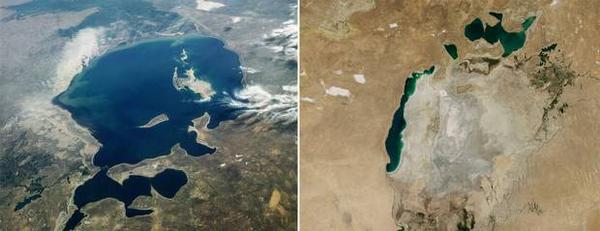| Online: | |
| Visits: | |
| Stories: |
NASA finds that Earth’s fourth-largest lake is almost completely dry
Wednesday, October 1, 2014 9:02
% of readers think this story is Fact. Add your two cents.
NASA finds that Earth’s fourth-largest lake is almost completely dry
Images from NASA’s Terra satellite have revealed some alarming results. The Aral Sea in Kazakhstan, which once was the fourth-largest lake in the world, is almost completely dry,The Independent reports.
The lake was once fed by two major rivers, the Syr Darya and the Amu Darya, which flowed through the Kyzylkum Desert, meeting at the basin’s end. Scientists attribute the Aral Sea’s decline to an irrigation project by the Soviet Union in the 1960s, which took water from the rivers to turn the desert into a farmland for cotton. The desert thrived, but the Aral Sea didn’t fare as well.
The images, taken by the Moderate Resolution Imaging Spectroradiometer on the Terra satellite, reveal that the Aral Sea’s eastern lobe has completely dried up. NASA began collecting the images in 2000, when the effects of the ’60s-era project were already evident. The photos show that the Northern Aral Sea separated from the Southern Aral Sea, and the lake has become “a fraction of what it had been before the irrigation project started,”according to The Independent.
After the north and south parts of the lake became divided, the lake’s eastern lobe completely dried up in 2014, NASA found. The lake’s retreat has caused trouble for the local communities, too — the water that’s still in the Aral Sea has been polluted with fertilizer and pesticides, causing a public health hazard, according to the NASA Earth Observatory. And “to compound matters, more water has been taken from the rivers to flush out the cropland affected by the contaminated dust that had blown up from the lakebed,” The Independentnotes, leading to colder winters and warmer summers.
“This is the first time the eastern basin has completely dried in modern times,” Philip Micklin, an Aral Sea expert at Western Michigan University, said in a statement for NASA’s Earth Observatory. “And it is likely the first time it has completely dried in 600 years.”
Take a look at the Aral Sea’s retreat in the images below.

Source:






The Aral last dried up in the Middle ages, the area has had an unusually dry period combined with a Soviet era irrigation scheme for cotton plantations responsible for the pesticide residue. The Sea will not completely dissapear due to a dam being created to preserve the northern portion while measures are introduced to restore its volume.
Both events were partly due to irrigation, but mostly long term variability. Last Drying periods in the 7th C and around 13 th C when the Amu Darya river shifted its flows between the Uzboy and the Aral sea after the dam diverting the entire flow to the Aral was destroyed by Gengis Khan in 1221.
In fact the existence of the Aral sea in the form known was entirely due to the damming of the Amu Darya to re-create the sea after the 7th C, it is therefore man made.